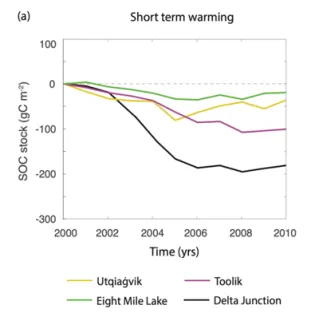Alaskan carbon-climate feedbacks will be weaker than inferred from short-term manipulations
To demonstrate that a well-tested mechanistic ecosystem model accurately represents observed carbon cycle and active layer depth responses to short-term summer warming in four diverse Alaskan sites; showing that short-term warming manipulations do not capture the non-linear, long-term dynamics of vegetation, and thereby soil organic matter, that occur in response to thermal, hydrological, and nutrient transformations belowground.
This study used a mechanistic land model, Ecosys, to demonstrate that short-term (< 10 year) warming experiments produce emergent ecosystem carbon stock temperature sensitivities inconsistent with multi-decadal responses due to the tightly coupled, nonlinear nature of high-latitude ecosystems.
While valuable for informing mechanisms stimulated under perturbation, short-term warming experiments cannot, by their nature, account for processes emerging on longer time scales that play a role in determining whether a site is a carbon sink or source. This study shows that short-term warming manipulations do not capture the non-linear, long-term dynamics of vegetation, and thereby soil organic matter, that occur in response to thermal, hydrological, and nutrient transformations belowground.
Bouskill NJ, Riley WJ, Zhu Q, Mekonnen Z, and Grant R. Alaskan carbon-climate feedbacks will be weaker than inferred from short-term manipulations. Nature Communications. https://doi.org/10.1038/s41467-020-19574-3
This research was supported by the Director, Office of Science, Office of Biological and Environmental Research of the U.S. Department of Energy under contract DE-AC02-05CH11231 to Lawrence Berkeley National Laboratory as part of the Next-Generation Ecosystem Experiments in the Arctic (NGEE Arctic) project.


